新英美概况 教学课件 齐智英英美概况电子教案齐智英 unit 1
- 格式:ppt
- 大小:4.39 MB
- 文档页数:68



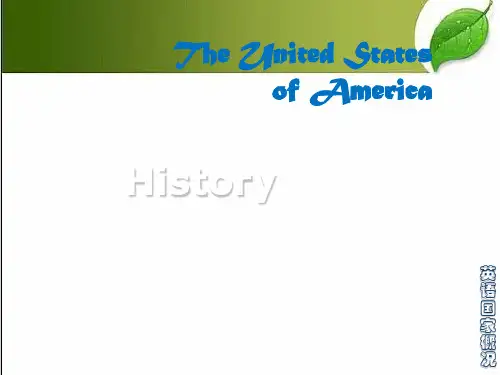
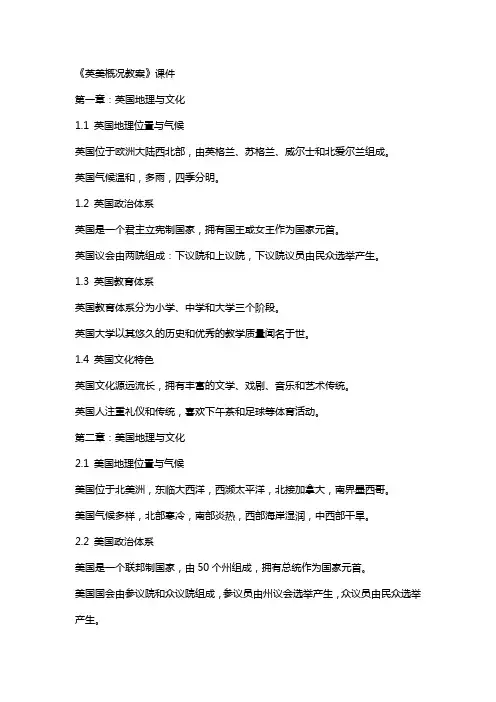
《英美概况教案》课件第一章:英国地理与文化1.1 英国地理位置与气候英国位于欧洲大陆西北部,由英格兰、苏格兰、威尔士和北爱尔兰组成。
英国气候温和,多雨,四季分明。
1.2 英国政治体系英国是一个君主立宪制国家,拥有国王或女王作为国家元首。
英国议会由两院组成:下议院和上议院,下议院议员由民众选举产生。
1.3 英国教育体系英国教育体系分为小学、中学和大学三个阶段。
英国大学以其悠久的历史和优秀的教学质量闻名于世。
1.4 英国文化特色英国文化源远流长,拥有丰富的文学、戏剧、音乐和艺术传统。
英国人注重礼仪和传统,喜欢下午茶和足球等体育活动。
第二章:美国地理与文化2.1 美国地理位置与气候美国位于北美洲,东临大西洋,西濒太平洋,北接加拿大,南界墨西哥。
美国气候多样,北部寒冷,南部炎热,西部海岸湿润,中西部干旱。
2.2 美国政治体系美国是一个联邦制国家,由50个州组成,拥有总统作为国家元首。
美国国会由参议院和众议院组成,参议员由州议会选举产生,众议员由民众选举产生。
2.3 美国教育体系美国教育体系分为小学、中学、高中和大学四个阶段。
美国大学以其多样性和创新性著称,拥有世界上最多的大学排名前100的名校。
2.4 美国文化特色美国文化多元且开放,拥有丰富的音乐、电影、科技和体育传统。
美国人注重个人主义和自由,喜欢户外活动、运动和社交聚会。
第三章:英国经济概况3.1 英国经济简述英国是发达国家之一,拥有强大的经济实力和先进的技术产业。
英国经济以服务业为主,特别是金融服务业在全球具有重要地位。
3.2 英国主要产业英国拥有发达的制造业,包括汽车、航空、制药等行业。
英国科技产业发展迅速,特别是在、生物科技等领域。
3.3 英国经济政策英国政府采取自由市场经济政策,鼓励企业创新和发展。
英国是欧盟成员国,与欧盟其他国家有着紧密的经济合作关系。
3.4 英国与他国的经济关系英国与美国、加拿大、澳大利亚等英语国家有着密切的经济合作关系。
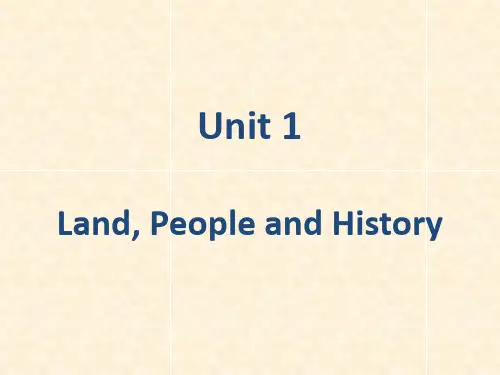
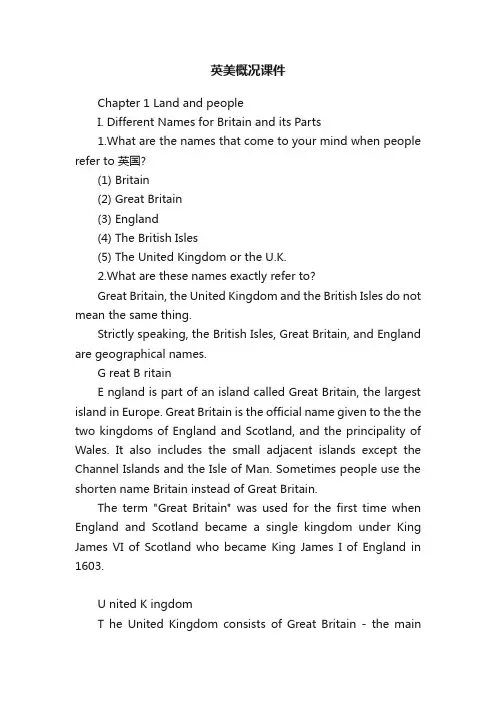
英美概况课件Chapter 1 Land and peopleI. Different Names for Britain and its Parts1.What are the names that come to your mind when people refer to 英国?(1) Britain(2) Great Britain(3) England(4) The British Isles(5) The United Kingdom or the U.K.2.What are these names exactly refer to?Great Britain, the United Kingdom and the British Isles do not mean the same thing.Strictly speaking, the British Isles, Great Britain, and England are geographical names.G reat B ritainE ngland is part of an island called Great Britain, the largest island in Europe. Great Britain is the official name given to the the two kingdoms of England and Scotland, and the principality of Wales. It also includes the small adjacent islands except the Channel Islands and the Isle of Man. Sometimes people use the shorten name Britain instead of Great Britain.The term "Great Britain" was used for the first time when England and Scotland became a single kingdom under King James VI of Scotland who became King James I of England in 1603.U nited K ingdomT he United Kingdom consists of Great Britain - the mainisland made up of England, Scotland and Wales - and Northern Ireland.The United Kingdom of Great Britain and Northern Ireland (UK) was formed in on January 1 1801 and constitutes the greater part of the British Isles. The largest of the islands is Great Britain, which comprises England, Scotland and Wales. The next largest is Ireland, comprising Northern Ireland, whichT he B ritish I slesThe British Isles include the UK, Great Britain, and other islands such as Ireland and the Channel Islands.The British Isles consists of:Great Britain (England, Scotland and Wales)The whole of IrelandThe Orkney and Shetland IslandsThe Isle of ManThe Inner and Outer HebridesThe Isle of WightScilly IslandsLundy IslandThe Channel IslandsPlus many other offshore islandsSummery:EnglandGreat Britain ScotlandWales U.K.2 large islandsNorthern IrelandBritish Isles IrelandRepublic of IrelandHundreds of (1949)small islands3.What is the official name of Britain?(1) The United Kingdom of Great Britain and Northern Island(2) For short: Britain, the United Kingdom or U.K.*The Union Jack--refers to the Union Flag or the National flag of the United Kingdom--It is called the Union Flag because it represents the emblems of the four countries united under one Sovereign - the kingdoms of England and Wales, of Scotland and of Ireland (although since 1921 only Northern Ireland has been part of the United Kingdom).--Although the name "Union Jack" is the popular name by which the flag is known to the world, it should strictly, perhaps, only be used for the flag when it is flown as a jack (a small flag flown at the bow of a ship); government documents generally prefer "union flag" as the more universally correct term4.Why do people often us e “England” and “English” to refer to “Britain” and“British”?England is the largest, post populous, and the richest.Largeness Size Pop.England biggest 60% 85%Britain Scotland 2nd largest 30% 1/10Wales smallest 9% 5%5.British imperial expansion“The sun never sets on the British Empire”(1) Ruled 1/4 of the world?s population and 1/4 of world?sland(2) Had colonies in North America, Asia, Africa, Austrialia6.British Commonwealth (Commonwealth of Nations)The term …Commonwealth? has been used to replace the word …Empire? to describe collectively the independent countries associated under the British crow(1) A free association of countries used to be English colonies(2) 53 member countries at present(3) Functions: active in a number of areas including development, democracy, debtmanagement and trade.II. Geographical features1.Geographical positionThe United Kingdom of Great Britain and Northern Ireland (UK) is situated north-west of the European continent between the Atlantic Ocean and the North Sea. It has a total land area of 244,100 square kilometres, of which nearly 99% is land and the remainder inland water. From north to south it is about 1,000 kilometres long.(1) Northwest of Europe(2) North Atlantic Ocean(3) Separated from the rest of Europe by the English Channel2.Geographical features(1) An island country, surrounded by sea(2) Highlands in the north and west(3) Lowlands in the east and southeastA. Part of the great European PlainB. Level land and fertile soilC. farming(4) 3 natural zones in ScotlandA. the highlands in the northB. the central lowlandsC. the southern uplandsIII. Rivers and LakesImportant role of rivers in the country?s economy1.Important Rivers(1)the Severn RiverA.the longest in the countryB.only 338 kilos long(2)the Thames RiverA.the 2nd longestB.the most important riverC.336 kilos longD.Oxford and London are on the river(3)River ClydeA.the most important in ScotlandB.important commercial waterway2.the Lake District(1)in northwest England and North Wales(2)popular tourist attractions(3)the home of the Lake PoetsA.William WordsworthB.Samuel Taylor ColeridgeC.Robert SoutheyIV. Climate1.Typical feature of Britain’s climate“Other countries have a climate; in England we have weather.”The statement is often made by Englishmen to describe the peculiar meteorological conditions of their country.A maritime type of climate(1)rainy---abundant rainfallThe uncertainty about the weather tends to make the Englishmen cautious.“A foreigner may laugh when he sees the Englishman setting forth on a brilliantlysunny morning wearing a raincoat and carrying an umbrella, but he may well regret hislaughter later in the day!”(2)changeable and unpredictable, no clear cut of 4 seasons“In no country other than England, it has been said, can one experience four seasons in the course of a single day! Day may break as a balmy spring morning; an hour or solater black clouds may have appeared from nowhere and the rain may be pouring down.At midday conditions may be really wintry with the temperature down by about eightdegrees or more centigrade. And then, in the late afternoon the sky will clear, the sunwill begin to shine, and for an hour or two before darkness falls, it will be summer.”(3)Mild: no extremesIn England one can experience almost every kind of weather except the most extreme.temperature: 4-6℃in winter, 12-17℃in summer2.Factors influencing the climate(1)the surrounding waters(2)the prevailing south-west winds(3)the North Atlantic Drift (warm current)3.Rainfall(1) a steady reliable rainfall throughout the year(2)uneven distribution of rainA. a water surplus in the north and westB. a water deficit in the south and eastV. The People1.Population of Britain: characteristics(1)Densely populatedVery large population for such a small country.(2)Highly urbanized90% of the population is urban and only 10% rural(3)Unevenly distributedThe population is made up mainly of (composition of British population)A.the English (81.5%)B.the Scottish (9.6%)C.the Welsh (1.9%)D.the Irish (2.4%)2.Different ancestors(1)the English----the Anglo-Saxons(2)the Scots, Welsh, and Irish----the Celts3.Differences in character and speech between southern and northern England(1)Southerners speak the type of English closer to BBC EnglishGenerally speaking, southerners speak the type of English closer to BBC English.They do not have a special accent except the Cockneys from the East End of London.(2)Northerners speak broader EnglishHowever, the northerners speak broader English than thesoutherners, and often leaveout the article “the” and the possessive adjectives “my”, “your”, “their”, etc.4.The way the Welsh keep their language and culture aliveThrough Eisteddfodau (Eisteddfod)(1)The Eisteddfod (literally 'sitting') is a Welsh festival of literature, music, and song. Thetradition of such a meeting of Welsh artists dates back to at least the 12th century.The most important eisteddfod is the National Eisteddfod, held annually and usuallyalternating between North and South Wales, and taking place entirely in the Welshlanguage.(2)The Welsh are music lovers and are proud of their past.(3)Throughout the year they have festivals of song, dance and poetry called Eisteddfod(au),hold competitions in Welsh poetry, music, singing and art to keep the Welsh languageand culture alive.Chapter 2The Origins of a Nation (5000BC-1066)I. Early Settlers (5000 BC—55BC)1. The Iberians伊比利亚人(1)Who were the first known settlers (inhabitants) of Britain?The Iberians(2)When did they come to Britain?At 3000 BC during the New Stone Age(3)How do you know that the Iberians were the firstknown settlers to Britain?A. The proof is the long barrows (古墓冢) found, which were their communal burialmounds (公墓)B. the Stonehenge (圆形巨石群、阵):a.It is a circular group of large standing stones constructed before 2000 BC.b.It is regarded as one of the most important monuments of its kind in Europe.c.Exactly why it was built is unknown but it must have had religious and politicalsignificance.(There are many different ideas about the purpose of Stonehenge: it may have beena center of sun worship, and was perhaps an observatory)d.Some think the Stonehenge is associated with the Celts.2. The Beaker Folk宽口陶器人(以其铃、钟形宽口陶器而闻名)(1) When and where were they from?At about 2000 BC (at the early Bronze Age) the Beaker Folk arrived from the areas now known as Holland and the Rhineland.(2)Why were they so called? (How did they take their name?)from their distinctive bell-shaped drinking vessels (or beakers)(3)How about their civilization? (What did they bring with them?)a)The art of pottery makingb)The ability to fashion (ornament with patterns) bronze toolsc)The custom of individual buriald)The hill forts (堡垒) and small fortified towns (筑堡城镇). TheMaiden Castle is oneof the finest examples.3. The Celts(1) Who were the ancestors of the Scots, Welsh and Irish?The Celts were the ancestors of the Scots, Welsh and Irish(2) When and where were they from?They began to arrive about 700 BC, and may have come from eastern and central Europe, now France, Belgium and Germany(3) What were these people?A.They were Practised farmers. They drained much of the marshlands and built houses ofwood and wickerwork with a weatherproof coating of mud.(带有抗风化的泥层)B.They were ironworkers.(4) What was their religion?Druidism(德鲁伊德教),the Druids—the wise men, astrologers, soothsayers(占卜者)II. Roman Britain (55BC—410AD)1. What do you know about the Roman invasion of Britain?(1)British recorded history begins with the Roman invasion.(2)In 55 BC, the great Roman general Julius Caesar invaded Britain for the first time(partly to gather information about the island and partly to punish the Belgae who helped in fighting against the conquering Roman)the invasion was unsuccessful because of resistance, the successful invasion did not take place until nearly a century(3)In AD 43, Emperor Claudius invaded successfully(4)For nearly 400 years Britain was under the Roman occupation, but it was never a totaloccupation.First, as a result of resistance; Secondly, Roman troops were often withdrawn fromBritain to fight in other parts of the Roman Empire.2. the Hadrian’s Wall哈德良长城(公元2世纪,罗马皇帝哈德良下令修建的城墙,用于防御英格兰北部边境,抵抗克尔特部落的进攻)It was one of the two great walls built by the Romans to keep the Picts out of the area they had occupied and conquered.(1)After the Roman occupation, the Romans met with fierce resistance and attacks from thetribes of Scotland. These people were called Picts(皮克特人)because of their “paintedfaces”. )(2)The Romans realized that they could not conquer them. So they withdrew from the north,and built two great walls, the Hadrian?s Wall and the Antonine Wall, to resist the attacks)3. the Roman contribution(1) they built a network of towns on their military camps with the capital of London(the suffix –caster or –chester in English place names—Lancaster, Winchester—derives from castra, the Latin word for camp.)(2) the Romans constructed a network of major and secondary roads. From London, roadsradiated all over the country.(3) The Romans made good use of Britain?s natural resources. They built baths, temples,amphitheatres and beautiful villas.(4)The Romans also brought the new religion, Christianity, to Britain.4. Why was the Roman influence on Britain so limited?Although Britain became part of the Roman Empire, the Roman impact upon the Britons was surprisingly limited as a result of(1)the Romans always treated the Britons as a subject people of slave class.(2)The Romans and the Britons never intermarried during the 4 centuries.(3)The Romans had no impact on the language or culture of ordinary Britons.III. The Anglo-Saxons (446-871) 盎格鲁-萨克逊人1. Who were the Anglo-Saxons?The Anglo-Saxons referred to the three Teutonic tribes(日而漫部落)who invaded Britain in the mid-5th century. They were Jutes, Saxons and Angles.--The Jutes 朱特人, from today?s Denmark, came to Britain first for assistance to drive outthe Picts and Scots.--Then the Saxons from northern German--The Angles who also came from northern German and were to give their name to the English people.2. How did the Heptarchy (七王国) come into being?During the Anglo-Saxon invasion, the three tribes named the Jutes, the Saxons and the Angles settled in different parts of Britain which was divided into many kingdoms. Among them, there were 7 principle kingdoms of Kent, Essex, Sussex, Wessex, East Anglia, Mercia and Northumbria. So they have been given the name of Heptarchy.3. Offa’s Dyke欧发大堤(古代英格兰的巨大土方工程。

《英美概况教案》PPT课件目录•英美国家概述•英国概况•美国概况•英美教育体制比较•英美旅游资源推荐•总结回顾与拓展延伸PART01英美国家概述地理位置与自然环境地理位置英国位于欧洲大陆西北面,被北海、英吉利海峡、凯尔特海、爱尔兰海和大西洋包围;美国位于北美洲中部,北与加拿大接壤,南靠墨西哥湾,西临太平洋,东濒大西洋。
自然环境英国地形以平原为主,气候温和多雨,四季分明;美国地形复杂多样,气候类型丰富,包括温带大陆性气候、温带海洋性气候、地中海气候等。
历史发展与文化传承历史发展英国历史悠久,经历了罗马入侵、中世纪封建制度、文艺复兴、工业革命等重要时期;美国历史相对较短,但发展迅速,经历了独立战争、西进运动、南北战争、两次世界大战等关键事件。
文化传承英国文化以绅士文化、下午茶文化、皇家文化等为代表,具有深厚的文化底蕴;美国文化以自由、民主、创新为核心,融合了世界多元文化。
政治制度及特点政治制度英国实行君主立宪制,国家元首为女王,政府首脑为首相;美国实行总统共和制,国家元首和政府首脑均为总统。
政治特点英国政治稳定,政府更迭较少,政策制定和执行相对缓慢;美国政治竞争激烈,政府更迭频繁,政策制定和执行迅速。
经济实力与产业结构经济实力英国和美国均为世界经济强国,拥有庞大的经济总量和强大的国际竞争力。
产业结构英国经济以服务业为主导,制造业和金融业也较为发达;美国经济以服务业和高科技产业为主导,制造业和农业也占据重要地位。
PART02英国概况公元前55年与54年,罗马将军朱利叶斯·凯撒两次率军入侵不列颠,虽未成功,但对不列颠产生了深远影响。
罗马入侵与不列颠的崛起5-6世纪,盎格鲁-撒克逊人从欧洲大陆迁徙至不列颠,逐渐形成了英格兰的雏形。
盎格鲁-撒克逊人的迁徙与定居1066年,诺曼底的威廉公爵征服英格兰,建立了诺曼王朝,并引入了欧洲大陆的封建制度。
诺曼征服与封建制度的建立1688年,英国爆发光荣革命,推翻了斯图亚特王朝的专制统治,确立了君主立宪制。
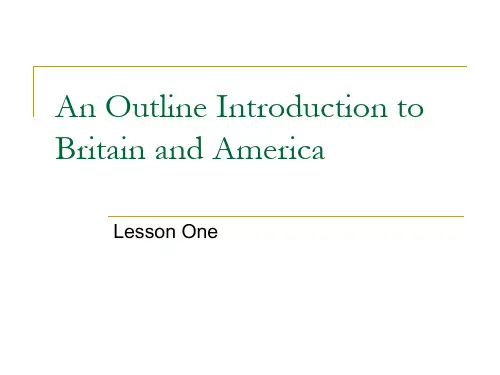


《英美概况教案》课件第一章:英国地理与文化1.1 教学目标:了解英国的地理位置和气候特点。
掌握英国的主要城市和地标建筑。
了解英国的历史背景和文化特点。
1.2 教学内容:英国的地理位置和气候特点。
英国的主要城市和地标建筑,如伦敦、大本钟、苏格兰的爱丁堡等。
英国的历史背景,如英国的君主制、伊丽莎白女王等。
英国的文化特点,如英国的语言、文学、艺术等。
1.3 教学活动:图片展示英国的地标建筑,让学生猜测并介绍。
分组讨论英国的历史事件和文化特点。
角色扮演,让学生扮演英国的历史人物或文化代表,进行对话展示。
第二章:美国地理与文化2.1 教学目标:了解美国的地理位置和气候特点。
掌握美国的主要城市和地标建筑。
了解美国的历史背景和文化特点。
2.2 教学内容:美国的地理位置和气候特点。
美国的主要城市和地标建筑,如纽约、自由女神像、华盛顿特区等。
美国的历史背景,如美国的独立战争、美国总统等。
美国的文化特点,如美国的语言、文学、艺术等。
2.3 教学活动:图片展示美国的地标建筑,让学生猜测并介绍。
分组讨论美国的历史事件和文化特点。
角色扮演,让学生扮演美国的历史人物或文化代表,进行对话展示。
第三章:英国教育体系3.1 教学目标:了解英国的教育体系和学校类型。
掌握英国的教育阶段和学历认证。
了解英国的高等教育特点。
3.2 教学内容:英国的教育体系和学校类型,如公立学校、私立学校、Technical and Further Education等。
英国的教育阶段和学历认证,如GCSE、A-Level、HND等。
英国的高等教育特点,如牛津大学、剑桥大学等。
3.3 教学活动:分组讨论英国的教育体系和学校类型。
案例分析,介绍牛津大学和剑桥大学等英国著名高校的特点。
角色扮演,让学生扮演英国的学生或教师,进行对话展示。
第四章:美国教育体系了解美国的教育体系和学校类型。
掌握美国的教育阶段和学历认证。
了解美国的高等教育特点。
4.2 教学内容:美国的教育体系和学校类型,如公立学校、私立学校、Community College 等。
英美概况教案(一)【教学目标】1. 了解英国和美国的基本地理、历史和文化概况。
2. 掌握英国和美国的主要城市、名胜古迹和自然资源。
3. 了解英国和美国的政治体制、教育制度和社会福利。
【教学内容】1. 英国的地理位置和地形特点。
2. 英国的历史概况:罗马时期、中世纪、工业革命、现代英国。
3. 英国的主要城市:伦敦、曼彻斯特、爱丁堡、伯明翰等。
4. 英国的名胜古迹:大本钟、白金汉宫、伦敦塔桥、牛津大学等。
5. 英国的自然资源:苏格兰高地、湖区国家公园、威尔士山脉等。
【教学方法】1. 采用多媒体教学,展示英国的地理位置、城市和名胜古迹的图片和视频。
2. 通过讲解和讨论的方式,让学生了解英国的历史、政治和社会文化。
3. 设置小组任务,让学生调查英国的自然资源和旅游特色。
【教学评估】1. 课堂讨论:学生能积极参与讨论,表达对英国的了解和看法。
2. 小组报告:学生能完成调查任务,呈现英国的自然资源和旅游特色。
3. 课后作业:学生能完成相关阅读材料,加深对英国的了解。
英美概况教案(二)【教学目标】1. 了解美国的基本地理、历史和文化概况。
2. 掌握美国的主要城市、名胜古迹和自然资源。
3. 了解美国的政治体制、教育制度和社会福利。
【教学内容】1. 美国的地理位置和地形特点。
2. 美国的歷史概况:殖民时期、独立战争、南北战争、现代美国。
3. 美国的主要城市:纽约、洛杉矶、旧金山、芝加哥等。
4. 美国的名胜古迹:自由女神像、白宫、国会山、哈佛大学等。
5. 美国的自然资源:大峡谷、黄石国家公园、尼亚加拉大瀑布等。
【教学方法】1. 采用多媒体教学,展示美国的地理位置、城市和名胜古迹的图片和视频。
2. 通过讲解和讨论的方式,让学生了解美国的历史、政治和社会文化。
3. 设置小组任务,让学生调查美国的自然资源和旅游特色。
【教学评估】1. 课堂讨论:学生能积极参与讨论,表达对美国的了解和看法。
2. 小组报告:学生能完成调查任务,呈现美国的自然资源和旅游特色。